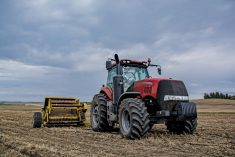As farms get larger and land more expensive, young people from small towns are packing up and moving to the big cities in search of career opportunities.
With a shrinking tax base, funding for the provision of services dries up, schools are shuttered, shops close, and doctors flee for greener pastures.
Sound familiar? It should. If you’re from rural Germany.
Europe’s economic powerhouse — with an average population density of 230 people per square kilometre (versus Canada’s 3.4) — is nevertheless struggling with many of the same issues as the Great White North.
Read Also

Journal pulls long-cited glyphosate study for ethics violations
The journal Regulatory Toxicology and Pharmacology has retracted a 2000 Monsanto-linked glyphosate review, drawing new scrutiny as Bayer faces mounting legal pressure.
Peter Dehne, a visiting professor from the University of Neubrandenburg, gave a presentation entitled “Boomtown and Schrumpfdorf side by side” at Brandon University’s Rural Development Institute in mid-October.
In a later email interview, he outlined some of the commonalities of both countries that he discovered after touring rural areas in Canada this past summer.
Many smaller communities, particularly in the former East Germany, are faced with a “downward spiral.” It’s not because of isolation or distance. With a population of 81 million in an area one-twenty-eighth the size of Canada, larger centres are within a 30-minute drive no matter where you live. Even so, in many small towns one in 10 houses lays empty, and in some towns hundreds of apartments are unoccupied.
The main problem is the fact that fewer babies are being born every year. Dehne said that demographers predict Germany’s population will decline by 10 to 18 per cent by 2050. In some regions in East Germany, it’s expected the population in 2030 will be half what it was in 1990 because of a rural exodus to the cities.
It becomes a downward spiral, said Dehne.
“There is a doctor shortage, health care is getting more difficult, schools must be closed, churches have less church members, and bus routes are closing down,” said Dehne.
“With that the quality of life gets worse. The disparities between the rural regions and the great cities are more and more increasing.”
In Canada, immigration is touted as the solution to rural depopulation, but in Germany, where over the centuries countless wars were fought to repel foreign invaders, that solution is a hard sell.
Immigration, at 250,000 per year, contributes up to two-thirds of Canada’s population growth, but in 2008 and 2009, Germany had more outmigration than immigration.
“We’ve got a shortage of workers and employees all over Germany. There is a lack even in rural, economically weak regions,” said Dehne.
“However, the social environment for immigration is difficult in small-town Germany. We don’t have that tradition and history of immigration like you have in Canada. I think it will be much more difficult to integrate immigrants in German municipalities.”
At Dehne’s university, half of the agricultural graduates go back to their parents’ farm to work, and half go on to work for agribusiness ventures. In the east, many large farms are operated as co-operatives or corporations with many employees overseen by a manager.
Farmland prices in Germany have tripled in the past decade, and land in Dehne’s area in the northeast sells for 15,000 euros per hectare (C$7,700 per acre).
“Mainly external investment companies are buying whole farms,” said Dehne. “They see farmland and farms as a good investment. But that seems to be a global phenomenon as well which is not always good for farming, food production and the rural regions.”














